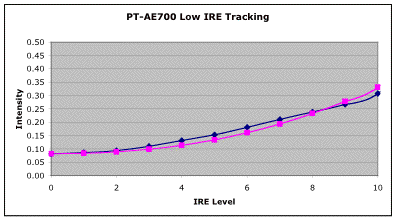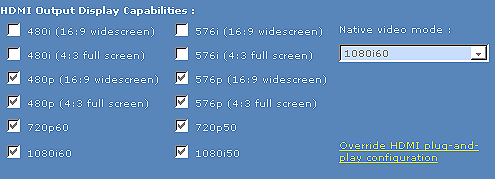Gamma Tracking
The other thing we can measure is Gamma Tracking, or how the light output of
the projector responds to the input signal. If the projector's Gamma
Tracking is off, then details in the image will either be lost, or the image
may look flat and have little contrast. The Gamma Tracking graph shows the
combined light intensity at the various IRE levels relative to a theoretical
level. If the projector is accurately producing the intended light intensity
level as a function of input or IRE level, all values should be close to 1
in the gamma tracking graph.

In the Gamma Tracking graph above, you can see that the PT-AE700U has
accurate tracking that is well described, with an overall gamma of 2.25. This
measurement was made using the Normal picture mode, and with the Dynamic
Iris off.

The Accupel signal generator also allows allows exploration of a projector's
ability to track the lowest IRE levels, as it has a mode where it will
output the signal in steps of 1 IRE. The graph above show the actual light level
of the PT-AE700U (blue) compared to the theoretical (magenta) for the
lowest IRE levels. As can be seen, the PT-AE700U produces a monotonic output
in this region (no flat spots) and should reproduce shadow details very
well.
Gamma Tracking with the Dynamic Iris Control Active

As mentioned above, with the Iris control on, the light level at the higher
IRE level was reduced as can be seen in the gamma tracking graph above. In
this case the Natural mode was used and the Dynamic Iris was on. The fall
off in the light level at the highest IRE levels was approximately twice a
large in the Normal mode. Again, the effect of the Dynamic Iris on overall
light levels will be discussed below.
Comments by JEJ - I tested the PT-AE700U using a
Kaleidescape Media Server with the Microsoft WHQL test disc version 3.0,
as well as the new Silicon Optix test disc. Input to the projector was at
480i through the component video connections. I also watched movies with the
Panasonic, through HDMI from the Kaleidescape, using 480p signals, and the
image quality was excellent. However, the projector would not accept 480i
through HDMI, so the test disc images had to be sent to the projector with
component video connections for the de-interlacing tests.
With WHQL, there was no line twitter in the Video Port
Performance Film Basic track or in the Alternate track, but there was moiré
present. In the Video Port Performance Video track, moiré and line twitter
were present. For the Silicon Optix disc, the projector passed the Color Bar
test, the Noise Reduction test, the Speedway Bleachers test, Cadence
tests, and Titles test. However, it failed the Jaggies test.
The Kaleidescape Output Display Capabilities menu
indicated that the projector would accept 480p, 576p, 720p, and 1080i
through its HDMI input, as shown below. (HDMI has two-way communication
between the source and display, so the source can get feedback information
from the display. The Kaleidescape's sophisticated setup menus will list a
projector's capabilities.)

Viewing and Comments
I watched a fair bit of HDTV programming, as well as DVDs, in the
time that I had the PT-AE700U, and overall I found the image to be very pleasing, indeed. In the
Natural picture mode (low lamp), the image was of similar brightness to my
reference Sony 11HT. With the Dynamic Iris on, the black levels were
noticeably better than my reference projector, but certainly not up to DLP
standards.
The ability of LCD projectors to produce well-saturated accurate looking
colors is also well illustrated by the PT-AE700U’s image. Once calibrated
for grayscale tracking and color saturation, the colors seemed to be right
on, and not at all washed out. Panasonic’s SST greatly reduces the screen
door problem as far as I am concerned, and the image is as smooth or
smoother than I typically see with 720p DLP projectors. SDE is an issue for
me, and I have generally found that the newer generation LCD-based projectors
have worse SDE, compared to my reference projector, likely as they are based
on smaller LCD panels, and therefore have a somewhat poorer fill factor. The
Panasonic projectors are a clear exception to this rule, and I consider their
SST a real breakthrough for LCD technology.
Perhaps a related issue is that, with the PT-AE700U, I saw evidence of Fixed
Panel Noise (FPN) which took the form of vertical banding. Most of the
time, this was not at all noticeable, but pans across blue sky, for
instance, could reveal a vertical pattern that was not part of the image.
Perhaps this is more noticeable because other pixel-based artifacts, e.g., SDE are reduced, or perhaps it is the nature of Panasonic’s LCD panels. (I
noted the same FPN issue with the Panasonic 500U.)
In the Normal mode, and as calibrated, the PT-AE700U is a different
projector than in the Native mode, much brighter and with noticeably
improved black levels, essentially as good as I have seen with some highly
rated DLP projectors, as the measured 1,665:1 Dynamic Contrast ratio would
suggest. This is especially impressive given the light output of 22.8 ftL at
my screen in the low lamp mode.
So does that mean a Dynamic Contrast ratio of say 2,000:1 is just as good as
a panel native contrast ratio of 2000:1? Is a Dynamic Iris the answer to all
our HT dreams? The simple answer is, "No”. The real answer is more complex,
and closer to “Not really, but it sure does help”.
The issues involve how the light output of given pixels in the display
follows the input stimulus for that pixel, what we normally call gamma
tracking. Ideally, a display device will output a light intensity for each
pixel in the image that is proportional to the input stimulus for that
pixel, modified by the projector's gamma characteristics. (A display device's
gamma is the exponential term in the power function that relates the actual
light output to the input stimulus.) Ideally, the light output for each pixel
will follow the input for that pixel and be independent of the other pixels
in the same image. This is essentially the way things work with display
devices that do not involve an active modulation of the lamp intensity or an
active iris. (It is not quite that simple, as light scatter in the projector
and/or room reflections may reduce the pixel-to-pixel contrast ratio at the
screen, but at least the pixels are “trying” to act independently.)
With an active iris, the light intensity of the entire display, i.e., all the
pixels, also changes with the “average” light intensity of the picture.
Thus, the light output for a given pixel no longer follows its input
stimulus alone, but is also dependent on the image as a whole. This is fine,
if, for instance, the whole image is completely black, the iris closes down,
and black levels are improved. If the image is all white, the iris opens up,
and one gets full light output. No problem so far, and the contrast ratio is
improved in the process.
With any full field image in between black and white where the whole image
is the same intensity, gamma tracking can be done properly with a dynamic
iris. There are potential problems with “dynamics” if your eyes detect the
iris working, but your own eyes have an iris that modulates the incoming
light by an order of magnitude, and that seems very natural, albeit on a
much slower timescale.
The iris actually works very quickly on the PT-AE700U and when switching
quickly back and forth from a full black window to a full white window, the
iris would make a noticeable click as it snapped open. I never heard the
iris during normal viewing, however.
The real issue with the Dynamic Iris can be found in the measurements reported
above. When the light intensity of an IRE 100 window was measured using the Accupel signal generator, the light intensity fell considerably, compared to
measurements with a full IRE 100 field or iris-off measurements. The Accupel-
generated IRE 100 window is a fairly small white window in the middle of a
black field. The PT-AE700U obviously senses this small white widow on a
black background as being a dark scene and largely closes down the iris.
Similar measurement using an Avia-based IRE 100 window and the Natural
mode produce a minimal diminution of window brightness, likely as the Avia
windows are much larger and cover 25% of the area of the screen (the Accupel-based windows are much smaller than the Avia windows).
So the real issue, then, is that bright objects in dark scenes may not get the
full brightness they deserve, and thus the image may lose some punch. This
is just the opposite of how CRT-based displays work, were typically peak
brightness with a small window is much brighter that a full white field.
While the above discussion suggests potential limitations in the use of a
Dynamic Iris, I did most all of my watching with the Dynamic Iris activated,
more often than not in the Natural mode, where the iris is perhaps a bit
less active. Overall, I’d say that the PT-AE700U makes good decisions about
when and how to use the iris, and I found that it improved my viewing
pleasure by producing better black levels in dark scenes, which, of course,
is exactly what it is intended to do.
Conclusions
The PT-AE700U might well seem to have it all with its bright image, well
saturated colors, Smooth Screen Technology that tames the Screen Door Effect
common with LCD-based projectors, DLP-like contrast ratios and black levels,
and all without single-chip DLP’s rainbow effect. Is this projector Nirvana
at last?
The answer is, “Not quite, but it comes pretty darned close . . . amazingly close
considering the PT-AE700U’s $2199 price”.
While the use of a the Dynamic Iris does greatly improve contrast ratios and
black levels, it is not quite as good as having the dynamic range present in
the native panels, i.e., Frame Contrast. Scenes with mixed light and dark segments could look a
bit washed out compared to an DLP projector with a similar contrast ratio.
Still, if you are at all bothered by “rainbows” with DLP-based projectors and
want to go the LCD route, or you are looking for one of the best values in
projectors that is available today, the Panasonic should be on your very
short list of projectors to try. I highly recommend it.
- Steve Smallcombe -